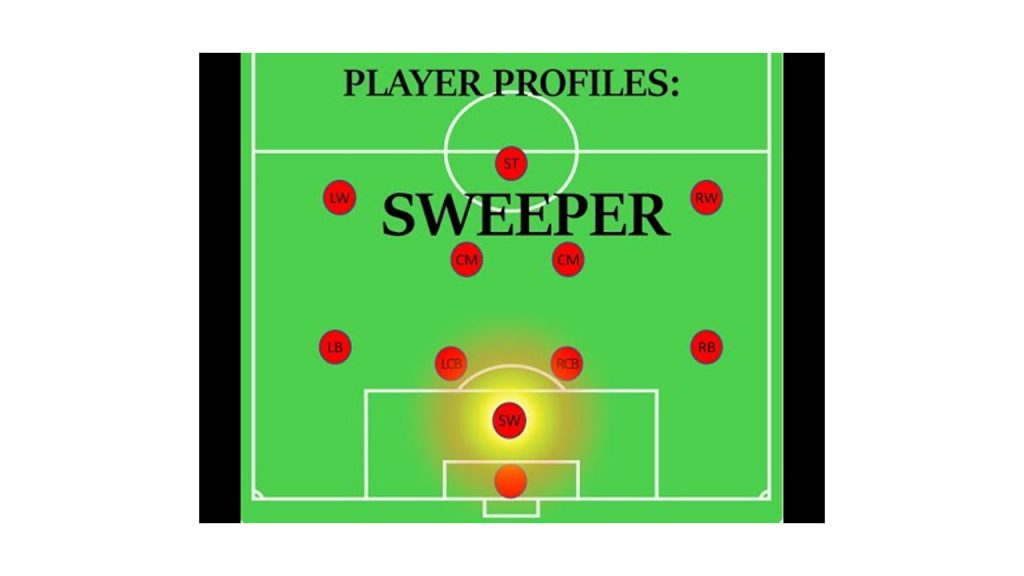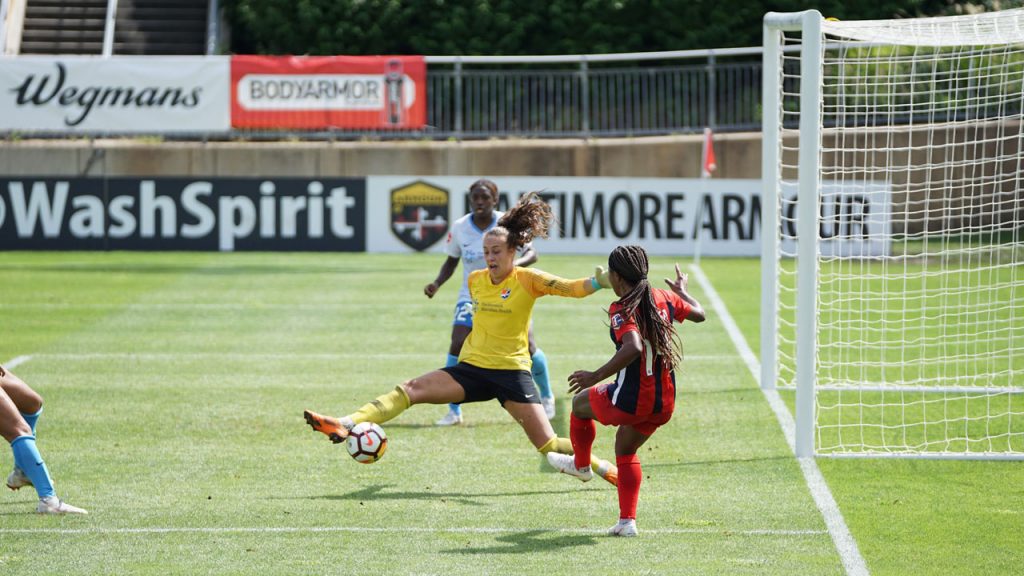Authority Soccer (authoritysoccer.com) is a participant in the Amazon Services LLC Associates Program, an affiliate advertising program designed to provide a means for sites to earn advertising fees by advertising and linking to Amazon.com. This site also participates in other affiliate programs and is compensated for referring traffic and business to them.
When fans are watching a soccer match and they are looking at their team’s defensive setup, they can see their normal back four, and sometimes they can see that their goalkeeper’s position is near the halfway line.
Or they see another player between the goalkeeper and center-backs, and they think why is this? What purpose does that serve? Read on and we will tell you.
The word stopper is another name for a center-back or a player who can sometimes play just in front of the back four.
While a sweeper is a player (usual goalkeeper) whose job is to cut out (sweep up) long balls that are played behind the backline.
What is a sweeper in soccer?
The role of sweeper in soccer refers to a player who is usually a goalkeeper, whose job is to cover or “sweep up” any balls that are played over the top of the defensive line.
Goalkeepers do this by altering their starting position on the field.
So, instead of being cramped inside the penalty box, the goalkeeper will move his starting position to around 20-30 yards out from the goal.
This is usually done because the opposition’s striker is extremely quick and along through the ball will give the striker the chance to get in on goal and potentially score.
However, when a goalkeeper is playing the role of sweeper, it negates this because once the ball is played in behind the defense, there is no free space for the striker to run onto the ball.
Because of the keeper’s positioning, he easily “sweeps” up the ball and gives it back to his team.
The perfect example of this is Manuel Neuer from Bayern Munich. He is regarded as one of the best goalkeepers in the world, not only because of his shot-saving abilities but also because of his sweeper abilities too.
However, it does not always work. Sometimes it works to perfection and it looks incredible, while other times it is just a straight-up disaster.
Check out the video of Neuer for Bayern Munich. Top 10 Manuel Neuer Sweeper-Keeper Moments – Advent Calendar 2015 Number 1 – YouTube
So as you can see, when it comes off it can be a real asset to the team however when it does not work, it can often lead to some disastrous situations like red cards and goals getting conceded.
Sometimes a goalkeeper will only play sweeper against certain opposition too, not in every game. This is because the need for a sweeper is not relevant for every match.
If a soccer team has a 6.5ft striker playing up front by himself, then there is going to be an exceptionally low chance that the striker is going to be able to run onto those through balls before the defenders catch up.
It is in this case where a sweeper is not necessary because the defense will have enough pace and be able to position themselves properly to avoid being caught out.
Then there are times when goalkeepers will have to play as a sweeper and act as kind of a fifth defender. A good example of this is playing against someone like Jamie Vardy from Leicester City or Cristiano Ronaldo from Juventus.
It is paramount that the backline has another form of defense against these speed merchants.
This is because if a ball is played over the top for them to run onto or a through ball is played and the defense is caught square then there is next to no hope of the defense catching up.
That is where the role of the sweeper is critical. Because of their pace, Vardy and Ronaldo can outrun basically anyone they want so their teams will attempt to play long balls to them to take advantage of their pace.
However, with a sweeper, getting them through on a goal like this is going to be ineffective because of the sweepers positioning in relation to the defense.
That is why when it is done right, opposing teams can sometimes feel powerless to score goals as often they are not playing against four defenders, they are playing against five.
Teams will use their goalkeeper as a sweeper instead of a center-back so it does not hinder their defensive line as well as providing the center-backs with confidence that they have help behind them if they need it.
What is a stopper in soccer?
As stopper is simply another term used to describe a center-back in soccer or a player who plays just in front of the backline as cover, usually as a defensive midfielder.
Depending on what type of formation the team is playing with, there can sometimes be two center-backs for example with the 4-4-2 formation (four defenders- two center-backs).
Then there are other formations such as 3-5-2-1 in which the side plays with three center backs instead of two and have two wing-backs offering defensive and offensive support.
Top high-quality center-backs are a rare breed as they can literally be the difference as to whether their team wins or loses the game. Because they play so close to the goal they cannot afford to make any mistakes because it could result in a goal.
Center-backs can also be useful in an attacking sense as well. For example, some center-backs have a great range of passing like David Luiz who currently plays for Arsenal.
When he picks up the ball in his own half, he can spray a ball all the way across the field to a winger and hit him on the chest to initiate a forward move.
Then there are corner kicks or free kicks inside their opposition’s half. Because naturally, center-backs dominate in the air, it makes them a genuine threat when taking a corner.
Because if you have a smaller striker the odds of him outjumping a defender to win the header is basically zero.
However, with a center-back, they are both tall enough and strong enough to battle to win the header and potentially score.
Then there is the midfield stopper. A team will usually deploy a stopper or defensive midfielder against a team that they expect will have pace and can easily get at the back four.
The stopper acts as a shield for the defensive line and covers for them.
For example, if the other midfielders get played through and are charging down one side of the field and drag a center back out of position to the wing, then the stopper will move back and slot into the vacant center-back role so there is no space left for the attacking team to exploit.
The other role for a stopper is to break up attacking plays against the opposition.
This can be a well-timed tackle when the opposition attacking midfielder is about the receive the ball or it could be to clog up the space between midfield and attack, making it difficult for the other team to break down the defense.
When it is done right it is ridiculously effective and it can seem like there is no way past the stopper to get to the goal.
It will seem like this because the stopper is constantly stopping forward attackers, always getting a foot into a tackle disrupting play, and just being a real nuisance for the opposition.
Some teams will even deploy two stoppers to protect the back four, however, when teams do this it can sometimes impact their ability to go forward.
This is because half of the team’s players (four defenders, two stoppers) main job is to defend, not attack, so it is crucial to find the right balance.
Sweeper/Stopper Formations
1-4-2-3

This formation is rarely used simply because it only gives the side two midfielders. It is a very defensive formation and as you can see the center-backs have cover behind them as well as the goalkeeper too.
5-3-2

This formation is still used today however most sides will move the sweeper into the midfield if support is needed.
When looking at this formation there are essentially three center-backs with two wing-backs who will provide both defensively and offensively to their team.
The downside is that with only one central midfielder the side is going to be very easily overrun by the opposition.
This is because if the opposition is playing a 4-3-3 then straight away there is going to be an outnumber in midfield, 3 players to 1 and this will not end well.
With two midfielders basically having free roam of the field they are going to have the time and space to try and pick apart the defense.
It is a very defensive formation and a team that sets up this way is saying to the opposition that we are not going to beat today.

